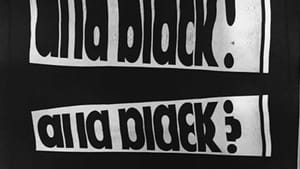Stay in the Loop
BSR publishes on a weekly schedule, with an email newsletter every Wednesday and Thursday morning. There’s no paywall, and subscribing is always free.
ICA’s Speech/Acts reinvents the languages of black experience

Language shapes our view of the world and how we function in it. It is a device that articulates our histories and experiences. The silencing of language can be an instrument of oppression; revitalized language ignites action. Language disjoints and distorts our very understanding of it. What happens when language becomes a vigorous cogitative exercise? Do we flee from it? Or do we wrestle with it? At the University of Pennsylvania’s Institute for Contemporary Art (ICA), Speech/Acts invites us to do the latter.
Questioning language
Opening Wednesday, September 13, and running through December 23, this exhibition uses experimental black poetry to unpack how the social and cultural constructs of language have fashioned black American experiences. The exhibition seeks to dismantle our basic understanding of language through highly conceptual art installations as well as a reading group that will meet on six Saturdays during the course of the exhibition, in which poetry novices are invited to join the conversation.
“I think that poetry can operate as a tool to interrogate and usurp language,” and that’s an important part of the show, explains Meg Onli, assistant curator at ICA. “We are othered as black people through language. Blackness is constituted through language. We are gendered through language,” she continues. “What does it mean to pick up a tool and to use something that can interrogate that? Experimental poetry is that tool that these artists have really locked in on.”
The multiplicity of blackness
In her first exhibition for ICA, Onli has curated the work of six visual artists (Jibade-Khalil Huffman, Steffani Jemison, Tony Lewis, Tiona Nekkia McClodden, Martine Syms, and Kameelah Janan Rasheed) and assembled special programs and a reading room spotlighting the work of poets Claudia Rankine, Morgan Parker, and Simone White.
The show is a conversation among artists of diverse practices who have drawn from experimental poetry (as well as more traditional text forms like film, magazines, TV, and books) to deconstruct and disturb language’s intended purpose through collage, drawing, text-based installations, and video.
“The show is a testament to the multiplicity of blackness,” Onli explains. “We are not a homogenous group. . . . This is not a monolithic blackness.”
“Speech can be written, it can be spoken. There can be written iterations of it, in a more poetic sense,” she says. “What does it mean to give six artists a platform and say, ‘Okay, what are you saying?’”
Who needs lines?
With two thought-provoking installations in the exhibition, conceptual artist Kameelah Janan Rasheed examines the traditions of black experimental writing. What she has to say focuses in part on pushing the boundaries of the legibility and dexterity of language. In one piece, Rasheed covers a 30-foot wall with roughly 2,500 sheets of Xeroxed paper containing fragments of text. Playing on the discomfort we might feel faced with text that is unfamiliar, Rasheed’s exhibition makes language move and spiral, not just with how it looks and sounds, but with how it literally functions within a space.
“Blackness is often solidified to be in a fixed state — 'this is how all black people exist, this is how all black life exists,'” she says. But she’s not interested in putting things in a line. The texts could rise high, move at eye or ground level, or slide off the wall. The ICA installation is “a space to play with language. We often read things in a straight line and go from one end to another, and I’m really interested in what it means to read a space.”
Bring your own lens
Rasheed hopes to challenge how people read and understand language. Instead of walking away because they don’t immediately grasp what she is doing, she hopes visitors grapple with the pieces, engage with them, and do the work to hear her voice.
“It’s not a one-read show,” Rasheed says. “It’s a multiple-read show, where you come in the morning and have your coffee before work, come in after work, or you come during the weekend with your kids. It’s a show you want to see multiple times, with different lenses and with different people. Each engagement will yield something different.”
Speech/Acts runs September 13 through December 23, 2017, at the Institute of Contemporary Art at the University of Pennsylvania, 118 S. 36th Street, Philadelphia. The exhibition is free and open to the public, with viewing hours on Wednesdays from 11am to 8pm, Thursdays and Fridays from 11am to 6pm, and Saturdays and Sundays from 11am to 5pm. Visit online for more info.
Sign up for our newsletter
All of the week's new articles, all in one place. Sign up for the free weekly BSR newsletters, and don't miss a conversation.

 Jarreau Freeman
Jarreau Freeman